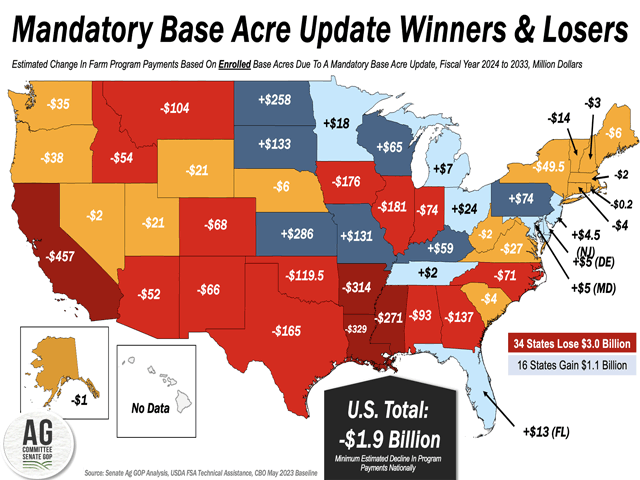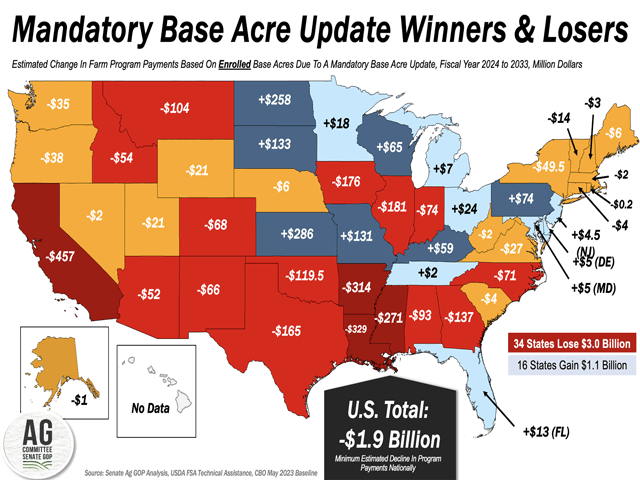Ag Policy Blog
Analysis: Base Acreage Update Would Save Money, But Create Winners and Losers
OMAHA (DTN) -- A new analysis by the Republican staff for the U.S. Senate Agriculture Committee looking at a mandatory update of base acres shows it would save taxpayers roughly $190 million a year in farm program payments, but also create "winners and losers" around the country.
The breakdown highlighting the impact of shifting base acres comes after members of the National Corn Growers Association (NCGA) voted last month to support a one-time mandatory update of base acres for commodity programs. NCGA stated an update would strengthen the Agricultural Risk Coverage and Price Loss Coverage (ARC/PLC) programs to better reflect farmers' recent planting history.
The proposal was pitched as Congress looks to write a new farm bill, now ideally targeting completion before the end of the calendar year. The current farm bill expires at the end of September. Some members of the House Agriculture Committee on Wednesday were in Minnesota for a listening session on the farm bill at the Farmfest show.
The analysis from the minority staff for the Senate Agriculture Committee on a mandatory update of base acres stated the economic impact would be "an overall loss of $2 billion to farmers and rural communities and economies due to a decline in farm program benefits during fiscal years 2024 to 2033."
The analysis added, "Few in agriculture benefit from a base acre update. A mandatory base acre update would create winners and losers among neighbors, crops, counties, and states, and most certainly would complicate efforts to successfully pass a new farm bill."
Still, the numbers from committee staff also reflect $1.9 billion in budget savings over 10 years that could be used to raise reference prices for commodities or improve the safety net through other areas.
The analysis highlights the impact of shifting acres to commodities farmers are now growing, but have a lower chance of collecting subsidy payments, which is one reason the American Soybean Association (ASA) has called for increasing reference prices. ASA also supports a voluntary update in base acres.
P[L1] D[0x0] M[300x250] OOP[F] ADUNIT[] T[]
The numbers show producers in 34 states would lose a total of $3 billion in ARC/PLC payments over 10 years while farmers in 16 states would see a gain of $1.1 billion in payments. States such as California (-$457 million), Louisiana (-$329 million) and Arkansas (-$314 million) would see the greatest declines while states such as Kansas ($286 million), North Dakota ($258 million) and South Dakota ($133 million) would gain in ARC/PLC payments over the next decade.
"This is largely due to significant shifts in commodity-by-commodity base-acre changes," the analysis stated.
Sen. John Boozman, ranking member of the Senate Agriculture Committee, is a Republican from Arkansas. Other principal leaders on the House and Senate agriculture committees have not commented on a mandatory update of base acres.
The gains and losses in farm subsidies would come because of shifts in crop production across the country. They would also assume no other changes were made to commodity programs.
States such as Georgia, the country's largest peanut-producing state, would see a decline in payments -- $137 million over 10 years -- because base acreage for peanuts would decline while seed cotton base acres would increase.
Farmers in Illinois could see a $181 million decline in payments while Iowa farmers would see $176 million decline -- over 10 years -- because they would lose acreage in corn base and add acreage in soybeans. States such as North and South Dakota would see gains because of increased corn production in those states.
While there are 11 total commodities with base acres, corn (100.7 million acres), wheat (69.7 ma), and soybeans (55.8 ma) take up 82.5% of all base acres nationally.
The states with the highest number of base acres are Iowa (21.5 ma), Kansas, (20.9 ma) and Illinois (20.2 ma).
The minority staff analysis concluded, "Instead of dividing agriculture, Congress has historically addressed base acres in a manner that benefits farmers by either adding or restoring base acres where needed or providing farmers an opportunity to reallocate their base. Under a voluntary base acre update farmers can re-proportion their base acres to meet their individual business needs -- avoiding the need for those in Washington, D.C., to hand-pick winners and losers in agriculture."
Senate minority staff analysis: https://www.agriculture.senate.gov/…
Also see, "Corn Growers Push for Mandatory Base Acre Update for Safety Net," https://www.dtnpf.com/…
Chris Clayton can be reached at Chris.Clayton@dtn.com
Follow him on Twitter @ChrisClaytonDTN
(c) Copyright 2023 DTN, LLC. All rights reserved.






Comments
To comment, please Log In or Join our Community .